THE Arnott family has a long history with food in Australia. Arnott’s Biscuits founder William Arnott began his baking career in the Hunter Valley after arriving from Scotland in the 1840s. Today his great-great-great-grandson Charlie Arnott continues the connection with food, although not under the biscuit label. He’s making his mark as a beef, lamb and pork producer at Boorowa, 65km north of Yass in South East NSW.
He’s also gaining accolades for his care of the land – most recently taking out the 2018 Bob Hawke Landcare Award. Announced last October, the $50,000 national award recognises individuals who champion the Landcare ethic and inspire others to take action. “This acknowledges not just the work I’ve done but the work of all regenerative farmers and what they’re achieving as stewards of the land,” Charlie says.
Raised on Hanaminno, the farm his father Michael bought in 1970 after leaving the family biscuit business, Charlie completed a Bachelor of Rural Science at the University of New England before returning to take up farming, using traditional methods. In 1997 he took over the property where he now lives with his family.
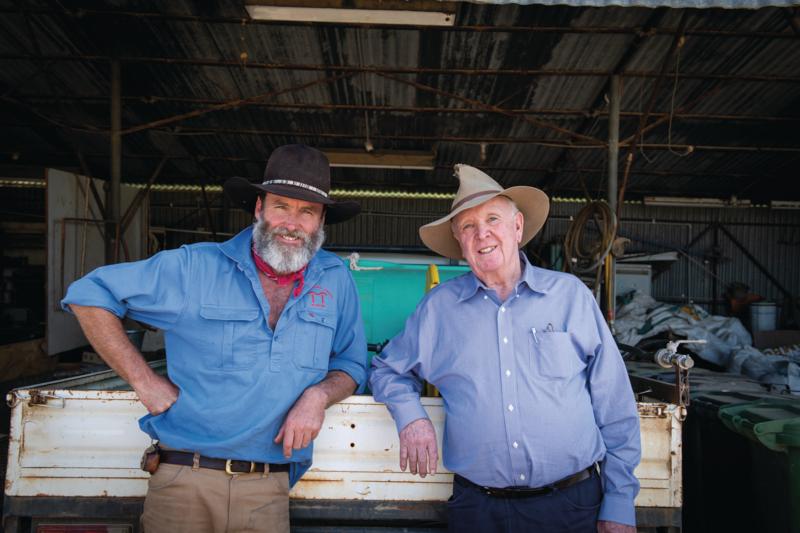 Charlie with his father Michael Arnott. Photography by Pip Farquharson.
MOVING FORWARD FROM CONVENTIONAL FARMING
Charlie with his father Michael Arnott. Photography by Pip Farquharson.
MOVING FORWARD FROM CONVENTIONAL FARMING
Fourteen years ago in the middle of the Millennium Drought an advertisement in his local newspaper caught Charlie’s eye. It was for a one-day course called Profiting from the Drought run by Resource Consulting Services (RCS). Charlie signed up and learned there were many alternative ways of thinking about farming and that it was okay to admit what he was doing wasn’t working. A week-long RCS Grazing for Profit course followed and Charlie found himself on a journey to prioritising care of the soil and land. He left behind conventional farming with its high input costs and says the first paddock he changed was “the one between my ears”.
RELATED ARTICLES:
-
Oyster growers thrive despite environmental crisis
-
Insects in overdrive: how dung beetles are helping farmers
-
Native vegetation: taming African lovegrass
-
The power of pig poo
“That course changed my life,” he says. “It broke a lot of paradigms and ways of thinking. I discovered the conventional or industrial way we’d been farming did not match my values or my family’s values and wasn’t serving us well.
“I knew what I was doing was not necessarily wrong. It just wasn’t as appropriate as I thought it would be and I made a commitment to change that. The course also made me focus more on what was in my control and less on what I couldn’t control.
“My business was so dependent on factors out of my control. So over a few years we reduced our inputs dramatically and adopted a whole bunch of tools that put me more in the driver’s seat.”
Today his farming toolbox is packed. He sees cows, trees, plants and biology as his tools. Charlie now grazes stock in larger mobs in rotation on smaller parcels of land for shorter times, and handles them carefully to minimise stress. He is intensively revegetating his land by planting trees and shrubs, and working to increase the number of perennial pasture species to build nutrient diversity. He fosters soil biology with natural composts made on the farm using biodynamic methods espoused in the early 20th century by philosopher Rudolf Steiner. It can be summed up as regenerative agriculture or, as Charlie puts it, “any method that works with or mimics nature”.
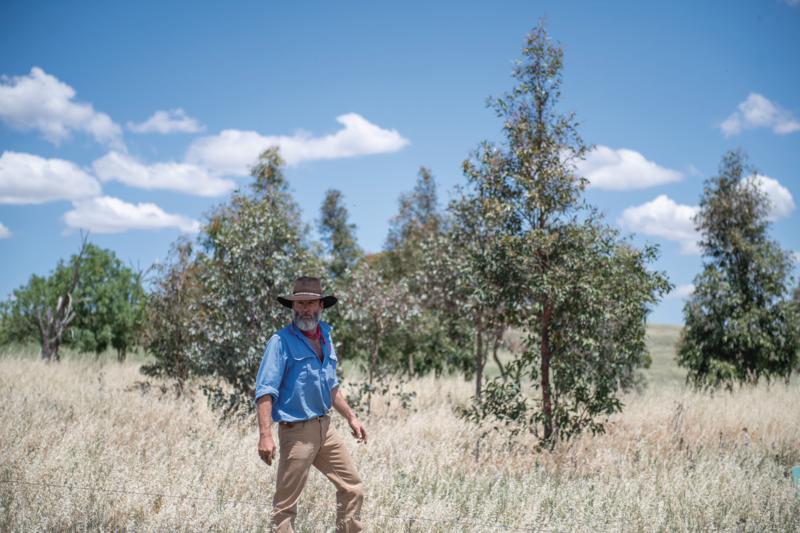 Charlie is slowly restoring the tree coverage on Hanaminno, creating wildlife corridors and helping to stabilise and improve the soil by planting a mix of native and exotic species.
Charlie is slowly restoring the tree coverage on Hanaminno, creating wildlife corridors and helping to stabilise and improve the soil by planting a mix of native and exotic species.
The family grows much of its own food. “My wife Angelica is an amazing cook and is very experimental,” Charlie says. “What she can do with the lamb and vegies coming out of the garden is amazing and that for us is really important. It’s a closed-loop food system.”
This year, Hanaminno is holding 200 Shorthorn cattle breeders, about 1,200 Merino and Dorset sheep and three Wessex Saddleback sows and their progeny. Annually the farm sends 250-300 head of cattle to market with 5-10% sold as premium-branded Charlie Arnott Grass Fed Beef. “We sell full beef and lamb carcases to butchers. Pork is boxed and sold locally,” Charlie says. “We also sell carcasses of lamb and pork to restaurants for special events and dinners or feasts where we tell the story about our business and our meat.”
Most of the sheep are traded online at AuctionsPlus or through saleyards, while 60-100 premium branded 18-25kg carcases go direct to customers at six-to-eight months of age. Trade cattle (those not bred on farm) are sold to Teys Australia and via AuctionsPlus. At $8/kg, Charlie’s premium beef earns $2.40/kg more than his trade cattle and his premium lamb fetches an extra $1-1.50/kg.
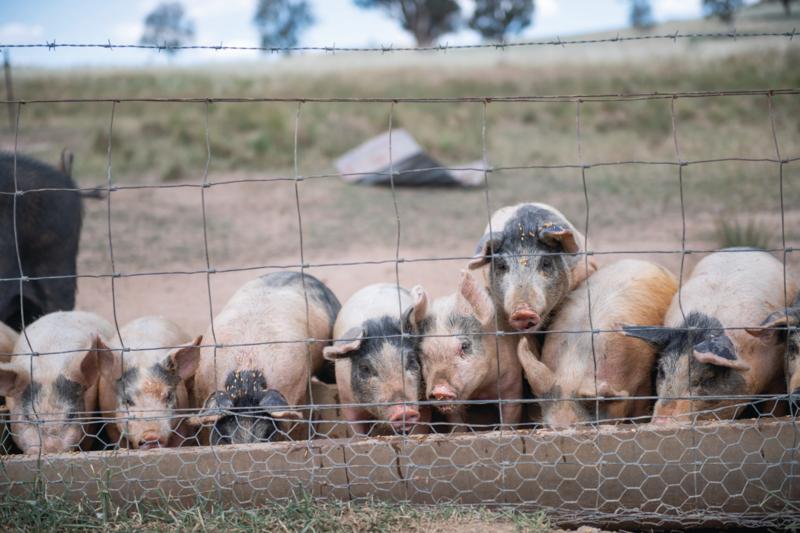 Young Wessex Saddleback pigs.
Young Wessex Saddleback pigs.
“We might buy cows or weaners to fatten but we don’t ever put anything we haven’t bred ourselves through our [premium] boxed-meat scheme because it’s not ours and we can’t say exactly what’s happened to them before they come to our farm,” Charlie says. “They could have been drenched and backlined [with pour-on pesticide] before we got them. While they’re here they get treated the same as our other animals and eat clean fresh pastures, but they’re purely for trading.”
CHARLIE FINDS TRUE CALLING IN BIODYNAMIC FARMING
While the farm is his sanctuary – “where I connect with nature” – Charlie spends much of his time off-farm, teaching other farmers about regenerative agriculture and biodynamic farming. He also earns income from real estate and other investments including a company that distributes food to restaurants and cafes in Sydney. But the 2,143-hectare bore-watered farm (there are two main unmetered operational bores, used to water stock, and two domestic ones) has to run profitably in its own right. Charlie employs a farm manager, a station hand and an office manager to keep things operating smoothly.
Hanaminno sits on hilly to undulating country with rich basalt and clay soils. About 30% of the property is arable and, like most of NSW, it’s in drought.“If I had to nominate an average annual rainfall it’d be 625mm but in 2018 we’ve had less than half that up to the beginning of November,” says Charlie. Despite this, he says the farm’s pastures will carry current livestock numbers through to late January/early February.
“That’s if it doesn’t rain. If we get rain between now and then it’ll grow more grass. We always like to have three months of feed in the paddock.” If there isn’t sufficient pasture, Charlie sells livestock in preference to buying in feed, which he hasn’t done for 14 years. He applies principles he learnt in a KLR Marketing course to determine what to sell first – usually the most valuable animal that eats the most. “Some people say let’s hang onto particular cows because they’ll be good to breed from, but I think that’s money running around the paddock on four legs,” Charlie says. “Selling them means you reduce your stock inventory but your grass and money inventories go up, and the more grass you have the more options you have.”
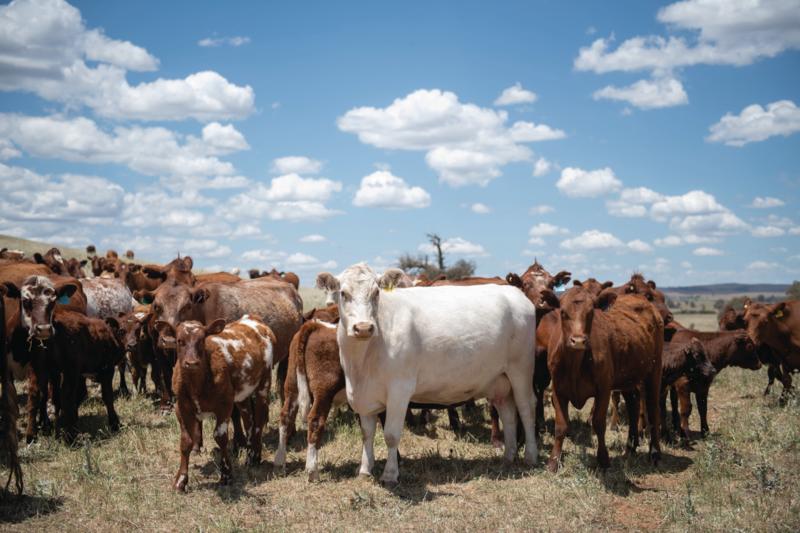 Some of Charlie’s Shorthorn Cattle grazing in their paddock.
Some of Charlie’s Shorthorn Cattle grazing in their paddock.
He says regenerative agriculture has taught him to “love our grass more than our cattle”, which is unlike the way he used to farm. “In a drought we would hang onto our cows. We’d then flog the grass and buy in feed for our cows to try to get them through. When we changed our thinking to love our grass more, retaining ground cover became our priority and when that happens the cows became a tool not a commodity.
“We use the cows and sheep to manage our grass so it’s maintained in a healthy state. If the grass is healthy, then it stands to reason your cattle will be healthy.”
Livestock are grazed in paddocks of 3-15ha, with each paddock rested for between 30 days and five months, depending on the season. “It’s short, sharp intensive grazing and there are lots of mouths and lots of hooves which disturbs the ground more than if they were in smaller numbers in a bigger paddock. That little bit of disturbance can help germinate seed, which is what you want,” Charlie says.
Each autumn, manure is collected from lactating cows and stuffed into horns and buried. By spring the manure has turned into a rich, black compost. This is diluted with water, run for an hour through a flow form (a set of three tiered bowls) to activate the microbes and then sprayed on paddocks, distributing about 50g of undiluted compost per hectare. “We use a fire tank on the back of the ute,” says Charlie. “This is one of the great things about this biodynamic way of farming. You don’t need fancy gear.”
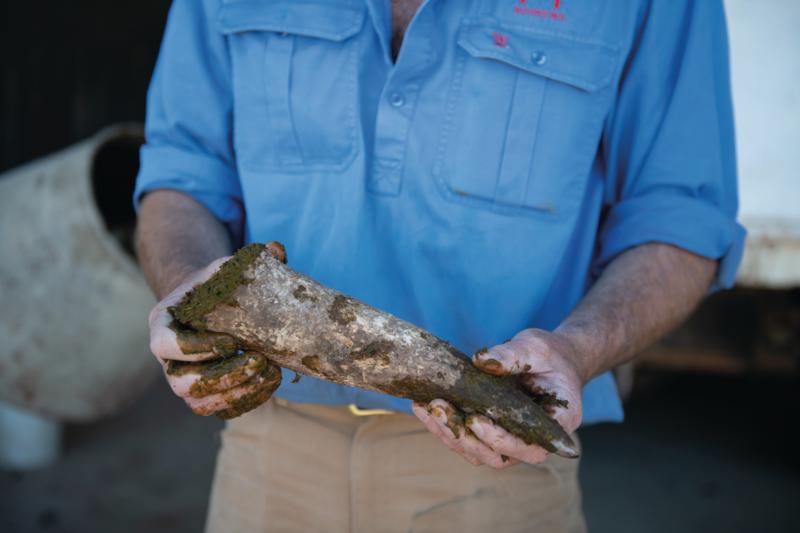 Charlie stuffs cow horns with manure then buries them, which turns them into a rich, black compost.
Charlie stuffs cow horns with manure then buries them, which turns them into a rich, black compost.
A second mix is made from cow manure blended in a cement mixer for about an hour with handfuls of eggshells and rock dust. This is poured into a small pit and five biodynamic preparations (intense mixes of various herbs and plants) are dropped into the mix in tiny amounts. Finally, a biodynamic liquid made from valerian blossom is sprinkled over it and the mix is covered with hessian and tin and left for three-to- four months. Once ready, it is mixed with water and sprayed on paddocks, at 150g/ha undiluted strength.
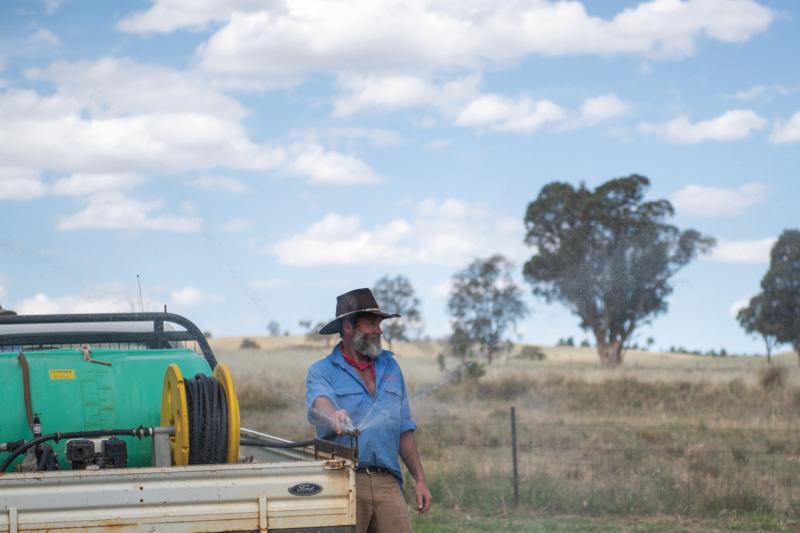 Charlie uses a fire-fighting tank to spray the preparations onto his paddocks.
VISIBLE ENVIRONMENTAL AND AGRICULTURAL BENEFITS
Charlie uses a fire-fighting tank to spray the preparations onto his paddocks.
VISIBLE ENVIRONMENTAL AND AGRICULTURAL BENEFITS
Charlie says the difference these biodynamic applications make to production, though not scientifically proven, is visible. Paddocks are greener and he feels the grass is more nutritious. “What we’ve observed is reasonably anecdotal,” he says. “We haven’t set up trials to measure how much grass we can grow or how many kilograms of beef per hectare we can produce, but we have observed that our cattle seem to be calmer. “We suspect the grass is more nutritious. The paddocks are lasting longer when grazed and we’re getting very good yields from our lambs and cattle, consistently 2-3% against conventionally farmed animals. The other thing is the soil is more resilient and absorbs more water.”
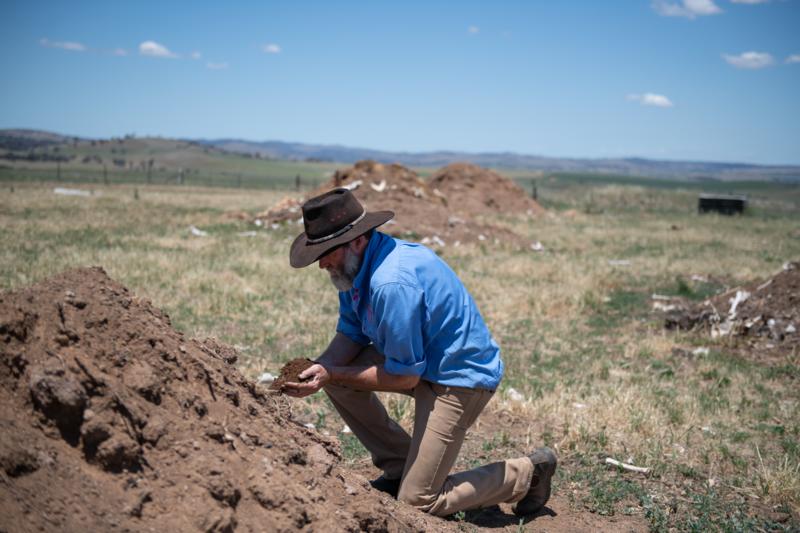 Charlie with some of his rich manure compost.
Charlie with some of his rich manure compost.
Charlie is also slowly restoring the tree coverage. He estimates that about 30% of the land was covered in trees before European settlement, but currently just 6% is covered. He wants to restore the coverage to at least 15% and every second year he sows native and exotic tree seeds into lightly tilled soils to create wildlife corridors of between 5-20km long. As they establish these will attract insects and birds, stabilise soil to prevent erosion and provide shelter and additional nutrition options for stock.
Charlie’s choice of trees sometimes raises eyebrows. While wattles and gums are part of the mix, he believes exotic deciduous species, such as honey locust and desert ash, will better heal “the wounded landscape”. He says they cycle nutrients better, afford more shade and have less impact on plants around them. He’s also replanting native Kurrajong trees which had been pretty well cleared out. “They’re also leguminous so they have a deep taproot and are bringing up nutrients.”
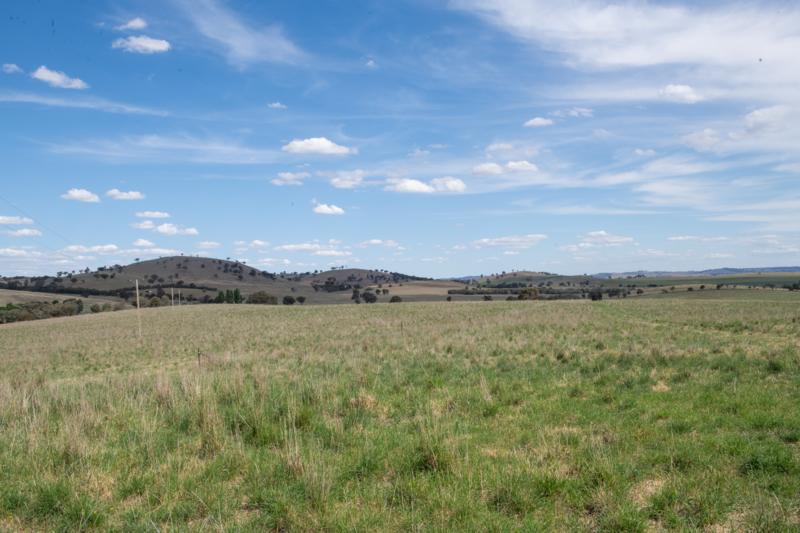 Charlie has changed his farming practices to focus on caring for the land and says his pastures are coping well, even in drought.
Charlie has changed his farming practices to focus on caring for the land and says his pastures are coping well, even in drought.
Charlie says regenerative farming seems a natural extension of caring for the land. He wants others to try it and plans to use his Landcare award money to offer more courses and document evidence of the effects of biodynamic and regenerative practices.
“Any farmer can do this, even someone in broadacre cropping,” he says. “If they were to apply two sprays of biodynamic preparations, I guarantee they will get a benefit from it. It’s very cheap and easy to apply. It’s not as if you have to go cold turkey and say no more urea. Start slowly. Put on your pesticides and herbicides but just start spraying the biodynamic preps. It’s about stepping slowly into it. Once you see the results, you might decide to do more sprays and slowly reduce your urea.”
HANAMINNO BY THE NUMBERS
200 Shorthorn cattle breeders.
1,200 Merino and Dorset sheep.
250-300 head of cattle turned off annually.
5-10% sold as premium-branded Charlie Arnott Grass Fed Beef.
60-100 premium-branded lamb carcasses sold direct to customers.
$8/kg - price earned by Charlie’s premium beef, which is $2.40/kg more than his trade cattle.
$1-1.50/kg - extra price fetched by premium lamb.
CHARLIE'S TOOLBOX FOR REGENERATIVE FARMING
- Cement mixer
For making a cow manure concentrate. Add manure, eggshells and rock dust. Mix for an hour. Set in the ground, add biodynamic preparations, then cover with hessian and tin. Leave for three- to-four months, then mix with water. Spray on paddocks in spring.
- Fire-fighting tank
Doubles as spray tank. For every hectare, dilute 150g of cow manure concentrate in 30 litres of water. Mix for an hour. Put in farm fire-fighting unit and spray on paddocks with fine-spray nozzle.
- Cow horns
Fill with manure from lactating cows. Bury. Dig up in spring. Dilute composted manure with water. Mix well and spray on paddocks.
- Flow form
Tiered bowls that emulate the flow of a mountain stream. Good for diluting biodynamic mixes and oxygenating water. Alternatively, mix compost preparations by hand using a figure eight movement.